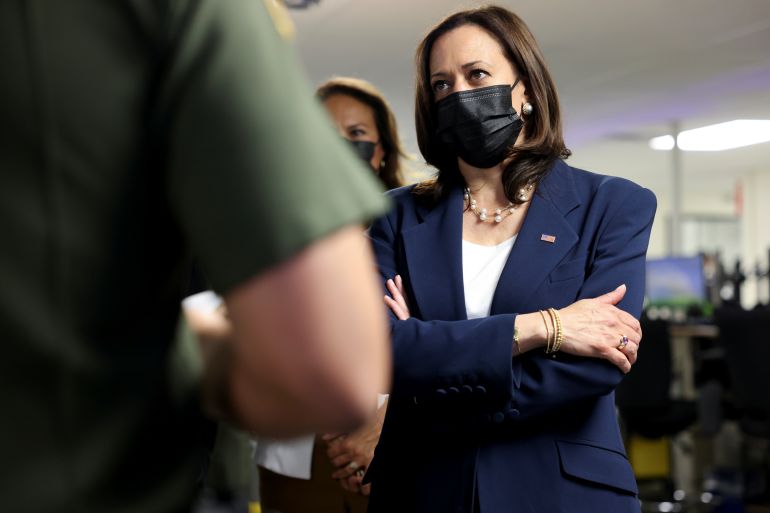Harris visits US-Mexico border amid criticism on immigration
The Biden administration is facing mounting scrutiny over its handling of a surge in migration at the border.

Vice President Kamala Harris visited a border patrol facility on the US-Mexico border and met with migrants on Friday in an effort to counter claims from Republicans that she has been too slow to visit the region as part of her role in addressing the root causes of immigration.
Visiting El Paso, Texas, Harris called the situation at the border “tough” and said more work is needed, anchored in a thorough understanding of why migrants leave their homes.
Keep reading
list of 3 itemsMexican and US officials discuss ‘root causes’ of migration
Biden names Harris to lead effort to stem migration at border
She met five young girls, aged nine to 16, who had been held at a Customs and Border Protection processing centre after crossing the border, the White House said, before visiting the border itself at the Paso del Norte Port of Entry.
“The stories that I heard today reinforce the nature of those root causes,” she said, adding, “It is going to require, as we have been doing, a comprehensive approach that acknowledges each piece of this.”
The meeting with migrant children reminded her that “this issue cannot be reduced to a political issue”, Harris said.
“We’re talking about children, we’re talking about families, we’re talking about suffering. And our approach has to be thoughtful and effective,” she continued.

During a meeting with faith-based organisations, as well as shelter and legal service providers, Harris said she and Biden “inherited a tough situation”.
But she maintained that “in five months we’ve made progress … there’s still more work to be done, but we’ve made progress”.
The trip, Harris’s first to the border since becoming vice president five months ago, was announced on Wednesday and is happening days before a visit to the border by former President Donald Trump.
“I said back in March I was going to come to the border, so this is not a new plan,” Harris told reporters shortly after landing. “Coming to the border … is about looking at the effects of what we have seen happening in Central America.”
Republicans have criticised President Joe Biden for rolling back restrictive Trump-era immigration policies even as migrant detentions at the US-Mexico border have reached 20-year highs in recent months.
Immigration remains a hot-button issue for both parties. Democrats and rights groups have pressed Biden to further scale back enforcement and ensure humane treatment of migrant children and families arriving at the border.
Harris has devoted much of her time in her new role to addressing what she calls the “root causes” of migration, namely poverty, crime and corruption in Central America.
Biden’s first few months in office have seen record numbers of migrants attempting to cross the border. US Customs and Border Protection recorded more than 180,000 encounters on the Mexican border in May, the highest in a month since March 2000.
Republicans have seized on those figures to attack Biden and Harris as weak on border security.

Administration officials, including Harris, have sought to push back against that perception, with Harris repeatedly sending the message to migrants during her recent visit to Guatemala: “Do not come.”
But those comments drew fire from some progressives, most notably Representative Alexandria Ocasio Cortez, who called the message “disappointing”.
Harris’s advisers have been careful to emphasise that her main focus related to immigration is addressing the root causes of migration. She has been seeking economic and humanitarian solutions to improve conditions for residents of Central and North American countries who flee to the US. Her aides framed her trip to the border as part of an effort to better understand how to solve the problem.
“What happens at the border matters, and is directly connected to what is happening in Guatemala, El Salvador and Honduras,” Sanders said. “It is directly connected to the work of addressing the root causes of migration.”